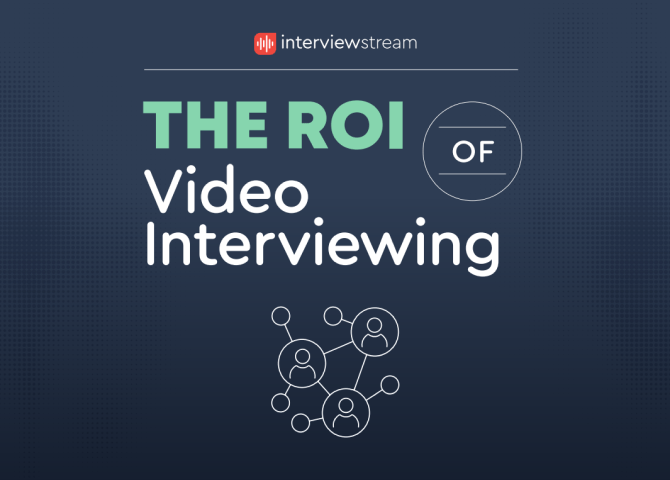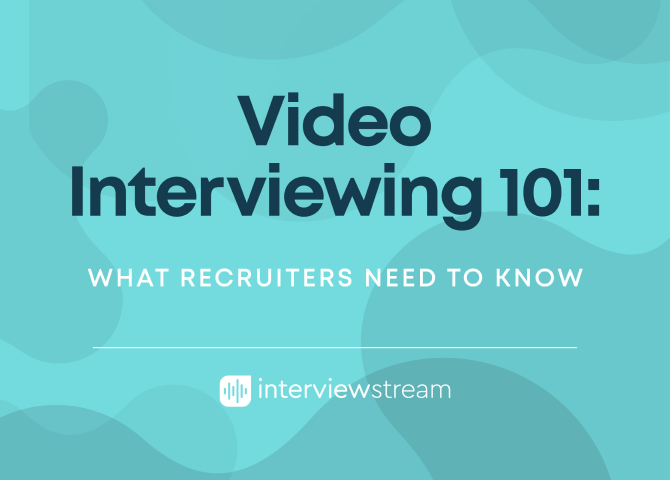2022 Mid-Year Workforce Projections for Every Industry

The rundown
- Inflation, inflation, inflation—everyone’s talking about it, and rising costs of living are applying intense pressure on employees and employers alike.
- Even with pandemic restrictions seemingly lifted for good, big conversations on work models and flexible benefits will continue well into the future.
- Creative job-filling techniques like upskilling and gig hires can help employers fill important gaps and pave a way forward while the talent shortage continues.
Table of contents
- 2022 in Recruiting: How It’s Going So Far
- K12 Education
- Higher Education
- Finance
- Government
- Healthcare
- Insurance
- Manufacturing
- Retail
- Staffing & Recruiting
- Technology
- Final Thoughts
- About interviewstream
2022 in Recruiting: How It’s Going So Far
The bad news? The Great Resignation is still happening—much to the chagrin of today’s people leaders. Trends suggest workers have continued to feel confident jumping ship for new opportunities this year, often seeking better benefits and higher pay. Employers have answered in kind and amped up their recruiting efforts to fill gaps—which only encourages more workers to leave their current jobs, and the cycle goes on.
The good news is that lifting pandemic restrictions seem to be the new normal, which means greater flexibility in job structures, recruiting strategies, and planning for the future.
What’s Coming Next
Many experts predict that an economic downturn may soon slow the turnover trend. With inflation at disconcertingly high levels, workers across industries are more likely to stay put in order to confront the increased costs of living with more confidence (but don’t be surprised if you hear more of your people asking for pay bumps). Similarly, those on the job hunt will probably feel some financial pressure to accept a new role more quickly in the current climate.
As in the last two years, employers can expect to face high pressure for good pay, flexible working models, and cultural transparency to compete for new talent. Those struggling to snag full-time hires, though, may find tapping into the gig economy and upskilling current workers can help provide creative solutions.
Interested in our HR newsletter? Sign up below!
Sign up for our newsletter – we send out a newsletter email two to four times a year which includes HR trends, industry-relevant knowledge, and the latest interviewing tips for recruiters and candidates.
K12 Education
As pandemic restrictions wane, K12 administrators are shifting their attention from the COVID-19 crisis to the staffing crisis. Sadly, this crisis is no small concern: some schools saw substitute fill rates of as low as 40% this school year. The instability continues to contribute to teacher burnout, bare-bones administrative functioning, substitute shortages, and more.
Projection: Administrators must continue to focus on teacher recruitment and retention for the coming academic year. Offering more flexibility to your staff can increase their overall reliability and sense of security (for example, don’t force teachers to take a full day off for an appointment that may only take an hour or two). Some districts are getting even more creative with affordable housing options, retention bonuses, and formalized career development programs.
Higher Education
Enrollment rates for colleges and universities are still down, and administrators are looking for ways to attract more students and continue leveling up their educational offerings. Still, their staffing needs might remain lower than normal as these institutions learn to adapt to the changing demands of their target markets.
Projection: If the Biden administration does pass student loan forgiveness or the economy does decline, optimism around the value of a college education might go up. Educators can increase their appeal to prospective students by enabling greater creativity among their instructors (and, in doing so, showcase the unique benefits of the curriculum only they can offer). Combining this creative appeal with practical skill-building will help their graduates succeed in the job market.
Finance
The financial realm is no exception to the labor shortage, especially as workers of all ages and life stages focus on self-care and minimizing stress. Additionally, the average age of financial advisors is now 55—and one-fifth of all advisors are over age 65. This means the shortage isn’t likely to improve any time soon as many financial professionals approach retirement. Fortunately, clear career development paths and good benefits can draw a lot of bright minds to this space.
Projection: Recruiters in the finance industry will want to screen and interview candidates with speed and agility to attract talent away from competitors. Using the best recruiting tech will also appeal to young candidates seeking forward-thinking, savvy employers who can help them get a good start in their careers.
Government
Although federal-level job growth remains unpredictable for the coming months, some evidence suggests that today’s young adults have more interest in civic engagement than they’re given credit for. The public sector is a contentious space of late, but those seeking to fill crucial roles in local government can appeal to candidates’ desires to improve their communities and make the world a better place.
Projection: As increased property taxes, driven by a still-hot real estate market, potentially give greater play to local governments’ budgets, these administrators should consider spending some of that funding on appealing to the next generation of public servants and employees. Carefully tailored interviews and consistent delivery can help them screen the best candidates—and put their best foot forward as potential employers.
Healthcare
The labor shortage in healthcare is still at critical levels, with burnout driving many front-line professionals to exit the space altogether. The gig economy has definitely played a part in filling the gaps: travel nursing arrangements are expensive for employers, but they have helped supply temporary workers during acute shortages, especially during COVID-19 surges.
Projection: Healthcare recruiters will need to remain agile—and fast—in their efforts to fill open roles across their organizations. This will mean continuing to get creative with benefits, working arrangements, and temporary staffing where required, but it will also mean pursuing the right recruiting tech to augment their efforts and get them in front of the best candidates more quickly.
Insurance
The pace of hiring in the insurance space has hit a steady clip this year, with 72% of carriers planning to increase staff. However, as with most other industries, meeting those goals for growth hasn’t been easy. Temporary workers, continued support for remote work, and developing and hiring from within can help. But recruiters face an uphill battle in appealing to new talent.
Projection: As inflation and supply chain issues continue to push replacement costs for insured assets up ever higher, insurers will continue to need analytics and actuarial experts to help fine-tune their policies and premiums. However, as these roles are the most difficult to fill, many will rely on reskilling existing employees or appealing to recent college graduates who will need on-the-job training to reach an ideal state of productivity.
Manufacturing
The manufacturing world is eager to get back on track after years of upheaval. While labor shortages and supply chain disruptions remain, many companies are adapting by reskilling employees, accelerating digitization and innovation, and leaning into brand and corporate responsibility efforts that draw more positive attention from candidates. It’s all shaping up to help the industry continue to recover this year.
Projection: The pressure is on for manufacturers to lean into their environmental, social, and governance (ESG) efforts these days. Both consumers and potential employees want to see improvements in these areas before they invest their money and time in these companies—but regulators, too, are putting higher expectations out there every day. Even small efforts, like more efficient and fair recruiting practices, can offer a simple but solid starting point to employers who want to dig deeper.
Retail
Though they’ve deployed tactics like increased pay and new perks in an effort to attract workers, retailers are still hurting for staff midway through 2022. Still, circumstances are improving, and many communities have noticed shorter wait times even if all those “Now Hiring” signs remain in place. Many storefronts are also adapting by shortening their hours or focusing on digitalization.
Projection: Some recruiters report that the focus in retail hiring has shifted from automated interview scheduling and internal hiring channels can help level up these efforts.
Staffing & Recruiting
It’s still a great time to be a recruiter. These folks are helping to tackle labor shortages across markets, and they’ve got a lot of freedom to prioritize their own work preferences when it comes to serving people leaders across the country. As a result, some HR teams are doubling down on hiring highly skilled recruitment experts in much-needed areas (hiring boutique or niche recruiting firms is a common approach). Alternatively, these teams might look beyond the traditional applicant field for internal recruiting hires and try giving professionals with different backgrounds a try at reskilling for this crucial role.
Projection: Niche recruiters are in—and they’re not likely to go away. In a talent market this challenging, both recruiters and the businesses they serve benefit from specialization and focused network building. You can attract these recruitment all-stars, in part, by promising to automate as much of their busywork as possible so they have plenty of time to focus on the more intellectual and interesting aspects of the job.
Technology
Tech companies of all types and locations are in an aggressive fight for talent, as the Great Resignation has leveled an outsized impact on this space. We’ve all seen the headlines debating which FAANG companies offer better benefits, more flexibility, or higher pay. For recruiters across the technology space, though, the bigger question is: how do smaller, less prominent companies compete with the big guys for talent? It’s harder and more expensive than ever to find tech talent right now, and teams everywhere are feeling the pain.
Projection: Once again, reskilling and hiring from within will be a critical factor in talent development for tech companies in the coming months. Boomerang hires are big, too. But when that isn’t enough, recruiters will be well served by minimizing the costs involved with screening and interviewing candidates, accelerating the process as much as possible, and evaluating candidates for potential and authenticity instead of just doling out formal assessments.
Final Thoughts
Although the Great Resignation may start slowing down soon, and several industries are beginning to recover from the upheaval leveled by the COVID-19 pandemic and its domino effects, the fact remains that a large talent gap continues to plague recruiters in every corner of the current economy.
This, however, is where the best recruitment practices can really shine. Today’s intense hiring landscape is the perfect breeding ground for new innovations in recruiting, interviewing, hiring, onboarding, retaining, and developing talent. In fact, countless recruiters are making booming careers for themselves by honing in on the skills and networks they need to lock in the next group of winners for their organizations.
They just need the right tools to help them do it.
Want to learn more about video interviewing?
Chat with a client success expert today and learn how to leverage remote interviewing solutions to simplify and personalize your hiring practices.
About interviewstream
interviewstream is an industry leading recruiting software company that helps you reach your top candidates more effectively. Our customers have completed over 3 million interviews using interview builder, interview on demand, interview scheduler, interview connect – and we’d love to help you as well. Talk to an expert today to learn how to get started.
The interviewstream platform
Speak to an expert today to learn how our remote interviewing solutions make hiring more effective.
About interviewstream
interviewstream exists to simplify your hiring process through our video interviewing and scheduling platform. We help you cut time, improve candidate experience, and automate scheduling so you can focus on what matters most–your candidates.



